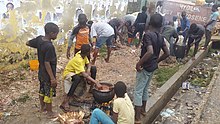
Back Kinderarbeid Afrikaans عمالة الأطفال Arabic Esplotación infantil AST শিশুশ্রম Bengali/Bangla Treball infantil Catalan منداڵانی کار CKB Dětská práce Czech Børnearbejde Danish Kinderarbeit German Παιδική εργασία Greek





| Part of a series on |
| Organised labour |
|---|
 |

Child labour is the exploitation of children through any form of work that interferes with their ability to attend regular school, or is mentally, physically, socially and morally harmful.[3] Such exploitation is prohibited by legislation worldwide,[4][5] although these laws do not consider all work by children as child labour; exceptions include work by child artists, family duties, supervised training, and some forms of work undertaken by Amish children, as well as by Indigenous children in the Americas.[6][7][8]
Child labour has existed to varying extents throughout history. During the 19th and early 20th centuries, many children aged 5–14 from poorer families worked in Western nations and their colonies alike. These children mainly worked in agriculture, home-based assembly operations, factories, mining, and services such as news boys—some worked night shifts lasting 12 hours. With the rise of household income, availability of schools and passage of child labour laws, the incidence rates of child labour fell.[9][10][11]
As of 2023[update], in the world's poorest countries, around one in five children are engaged in child labour, the highest number of whom live in sub-saharan Africa, where more than one in four children are so engaged.[12] This represents a decline in child labour over the preceding half decade.[13] In 2017, four African nations (Mali, Benin, Chad and Guinea-Bissau) witnessed over 50 per cent of children aged 5–14 working.[13] Worldwide agriculture is the largest employer of child labour.[14] The vast majority of child labour is found in rural settings and informal urban economies; children are predominantly employed by their parents, rather than factories.[15] Poverty and lack of schools are considered the primary cause of child labour.[16] UNICEF notes that "boys and girls are equally likely to be involved in child labour", but in different roles, girls being substantially more likely to perform unpaid household labour.[12]
Globally the incidence of child labour decreased from 25% to 10% between 1960 and 2003, according to the World Bank.[17] Nevertheless, the total number of child labourers remains high, with UNICEF and ILO acknowledging an estimated 168 million children aged 5–17 worldwide were involved in child labour in 2013.[18]
- ^ Laura Del Col. "The Life of the Industrial Worker in Nineteenth-Century England". Victorian Web.
- ^ "The Factory and Workshop Act, 1901". Br Med J. 2 (2139): 1871–2. 1901. doi:10.1136/bmj.2.2139.1871. PMC 2507680. PMID 20759953.
- ^ "What is child labour?". International Labour Organization. 2012.
- ^ Cite error: The named reference
UNwas invoked but never defined (see the help page). - ^ "International and national legislation - Child Labour". International Labour Organization. 2011.
- ^ "Labour laws - An Amish exception". The Economist. 5 February 2004.
- ^ Larsen, P.B. Indigenous and tribal children: assessing child labour and education challenges. International Programme on the Elimination of Child Labour (IPEC), International Labour Office.
- ^ "Council Directive 94/33/EC of 22 June 1994 on the protection of young people at work". Official Journal of the European Communities. 37. 20 August 1994 – via EUR-Lex.
- ^ Cite error: The named reference
ep99was invoked but never defined (see the help page). - ^ Hugh Cunningham; Pier Paolo Viazzo, eds. (1996). Child Labour in Historical Perspective: 1800-1985 (PDF). UNICEF. ISBN 978-88-85401-27-3. Archived from the original (PDF) on 23 November 2015.
- ^ Hindman, Hugh (2009). The World of Child Labour. M.E. Sharpe. ISBN 978-0-7656-1707-1.
- ^ a b "In the world's poorest countries, slightly more than 1 in 5 children are engaged in child labour". UNICEF. June 2023.
- ^ a b "UNICEF Data – Child Labour". UNICEF. 2017. Retrieved 18 April 2018.
- ^ "Child Labour". The Economist. 20 December 2005.
- ^ Cite error: The named reference
ep05was invoked but never defined (see the help page). - ^ Cite error: The named reference
ilo2008awas invoked but never defined (see the help page). - ^ Norberg, Johan (2007). Världens välfärd (in Swedish). Stockholm: Government Offices of Sweden. p. 58. ISBN 978-91-85935-00-0. Archived from the original on 6 February 2016.
- ^ "To eliminate child labour, "attack it at its roots" UNICEF says". UNICEF. 2013. Archived from the original on 25 February 2021. Retrieved 4 March 2014.